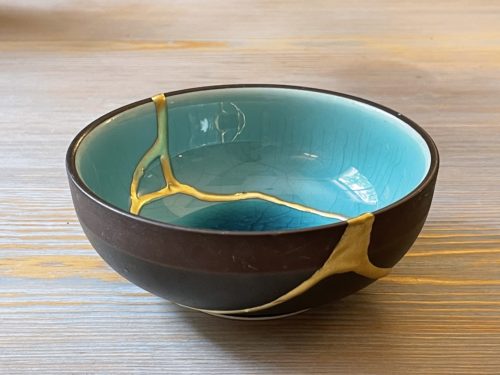Mended with Gold
by Gina Boyle, MSW, LCSWA
A few weeks ago, I dropped a ceramic dish (and my lunch) onto the linoleum floor in our office break room. I loved that dish – it was new and the edges were wrapped in a bright blue silicone sleeve which was supposed to protect it from breaking – but when the dish hit the floor it shattered dramatically. So much for the protective silicone armor I paid extra for….
When I looked down at the broken pieces, one phrase popped into my mind immediately: “It’s broken.” Not “It’s a broken dish” or “It’s my broken dish.” Not even a moment to consider whether it was repairable. No, as soon as my eyes registered that the dish was no longer new and perfect, my mind reflexively redefined what it was: it was broken. Flawed. All the value was gone.
Looking back, I’m a little surprised at how effortlessly this thought popped into my mind: one moment I was holding the dish, the next moment it fell, and then immediately a verdict was delivered. There was no conscious thinking, just an instantaneous reaction and judgment. I also wasn’t proud of how one-dimensional my perspective was, especially for a therapist (yep, we have cognitive distortions, too!). Because ironically, just down the hall on my office bookshelf, I proudly displayed something that represented the opposite perspective:
A kintsugi bowl.

Kintsugi – translated as “gold joinery” – is a 400+ year old Japanese ceramic art practice that considers breakage and repair to be key parts of the unique history of an object, and nothing to be concealed. According to legend, a 15th century Japanese military leader accidentally broke his favorite Chinese tea bowl and sent it to China for repair. However, when the tea bowl was returned, he was saddened to see that his treasured tea bowl had been crudely repaired with harsh metal staples. While the tea bowl was functional, the staples were an unsightly contrast to the beautiful piece. Hoping to find a craftsperson who would respect his cherished tea bowl enough to repair it respectfully, he entrusted it to a local craftsperson who saw how much he loved the bowl. Instead of the metal staples, this craftsperson rejoined the pieces with a mixture of lacquer and melted gold. Most notably, the cracks weren’t hidden and the repair was far more than merely functional. The gold joinery made the tea bowl more beautiful and even more valuable than it was in its original state.
The philosophy of kintsugi isn’t about highlighting the break; it’s about celebrating the repair. It’s a compelling metaphor for the possibility of change and growth, compassion and self-acceptance. Just as no two finished pieces of kintsugi are identical – all pieces of ceramic break in unrepeatable ways – wholeness and healing often look different for different people. In an effort to bring a tangible representation of these ideas into my practice, I found a kintsugi artist (thank you, Etsy!) and ordered a kintsugi bowl for my office.
When I first unwrapped and held the small bowl, my fingers traced the raised lines of gold, the ribbon of boldness across the aqua, teal & black glazes. I looked at the bowl from above, I looked at it sideways, I flipped it over. There was a certain sideways angle where I actually couldn’t see any gold at all; the break was completely hidden behind a curve. There was another angle where the gold looked like a splintered river, rushing over and under and around the curves, holding it all together.
I wondered what the bowl had looked like in its original, whole form, before the repair. I imagined that once upon a time it was probably a fine little bowl, seamless and smooth, perfectly nondescript. It was very easy to imagine that perfectly nice bowl, because I’d seen and held a version of that perfect little bowl thousands of times in my life. You probably have, too?
Yet, it occurred to me that if I had the choice of which version of the bowl I could hold, I wouldn’t choose the perfectly seamless and smooth version. True, I loved the form of the original, unbroken bowl…. there was nothing wrong with it, after all. But there was something special about the kintsugi bowl, about the splintered seams of gold that elevated it from an everyday object into something significant. Those rejoined cracks — carefully mended with gold — told a story:
Something happened here. Something happened to something valuable. And instead of forcing it back together with whatever was quick and easy, this valuable thing was repaired with just the right tools and with gentleness and patience. Because, the mending and healing of something valuable deserves to be celebrated with gold.
That’s the bowl I want. The one with the story.
May we all have the compassion and patience to mend ourselves with gold.
